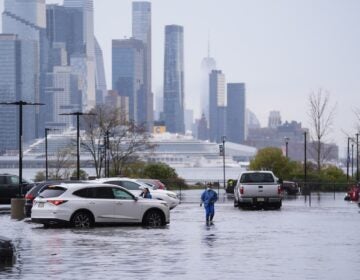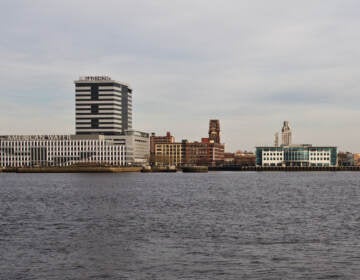New Jersey Pine Barrens offer up answers to tough climate questions
Rowan University has teamed up with the state to figure out the balance between the amount of carbon emitted by New Jersey wetlands, and the amount that gets absorbed.
Listen 7:40
Charles Schutte, an assistant professor at Rowan University’s Department of Environmental Science, holds soil dug up from an Atlantic white cedar swamp. He is teaming up with soil scientists and the NJDEP to determine the balance between how much carbon the swamp stores, and how much it releases. (Kimberly Paynter/WHYY)
This story is part of the WHYY News Climate Desk, bringing you news and solutions for our changing region.
From the Poconos to the Jersey Shore to the mouth of the Delaware Bay, what do you want to know about climate change? What would you like us to cover? Get in touch.
On a cool day in October, before any leaves have turned color, three researchers are traveling deep into New Jersey’s Pine Barrens. Leaving the paved roads behind, they pass by cranberry bogs and an Ocean Spray plant, and head into state land on a sandy pitted road. Deciduous trees fade away, and the road is soon lined with pitch pines decked with long tufted needles on irregular branches. Some of these pines have charred trunks, a testament to their fire retardant properties.
But this group, led by Rowan University professor Charles Schutte, and New Jersey Department of Environmental Protection wetland ecologist Josh Moody, is on its way to one of the few Atlantic white cedar swamps left in the state.
Atlantic white cedars once thrived in New Jersey but have declined in recent years, leaving only about 20% of the original acreage and prompting the state’s Forest Service to launch the Atlantic White Cedar Restoration Project.
“It was really a hallmark species of the Pine Barrens,” Moody said. “It was used for building. It grows really tall, really straight and is really resistant to rot. So you can imagine that’s a really sought after wood for a lot of items. The soil that it sits on is dependent on that particular tree, it’s a very carbon rich soil.”
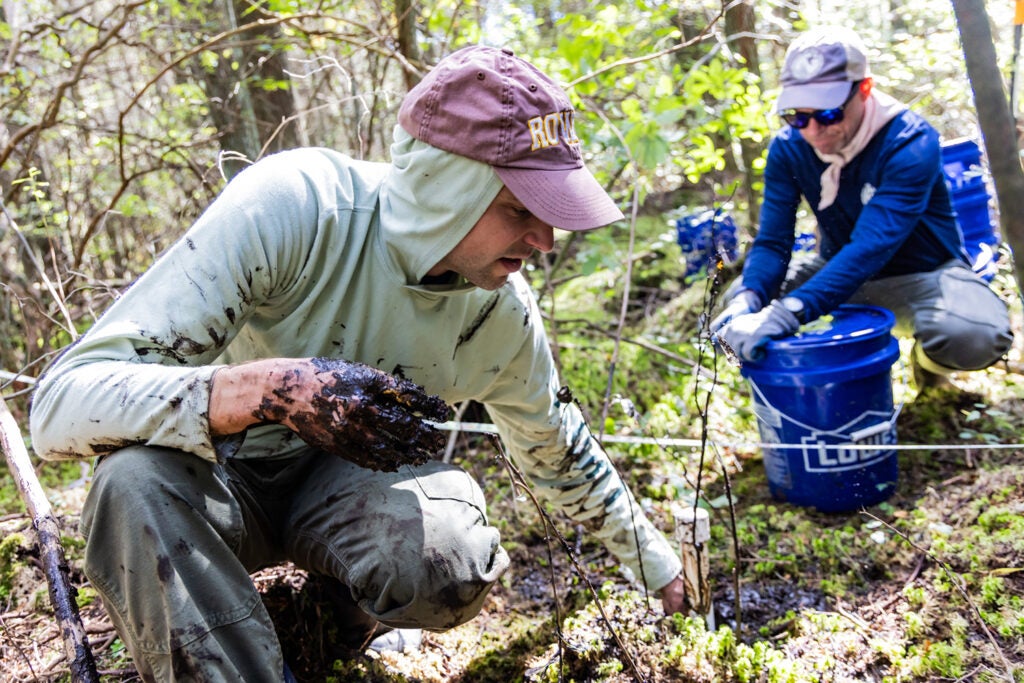
These researchers want to know how much carbon locked into that soil escapes and compare that to how much the cedar trees absorb.
New Jersey has some ambitious climate goals. The state wants to cut greenhouse gas emissions in half by 2030. One strategy focuses on how the state’s lands can be used to help absorb carbon emissions. But first, researchers need to learn the balance between how much greenhouse gas the state’s forests emit, and how much they absorb. The Atlantic white cedar forests are one of four types of wetland forests upon which this research project is focused. The others include two deciduous forests and another type of pine forest.
They’ve spent several years plotting out dozens of sites, narrowing it down to 12, and today is the first time they will start to install tools to measure the emissions in the Atlantic white cedar swamp.
Bushwhacking to the research site
Schutte and Moody pull their pickup truck over to the side of the road once they reach the Penn State Forest and quickly begin to unload their equipment – PVC piping, blue buckets and augurs, a hand tool used in drilling wells.
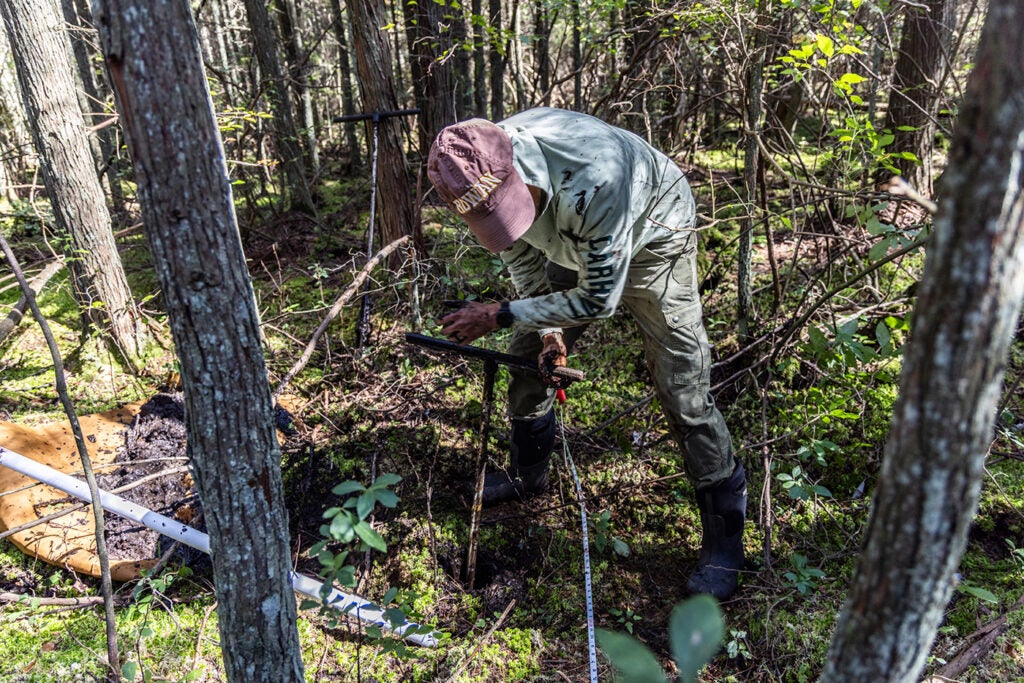
They want to know if the amount of carbon the swamp’s trees absorb through photosynthesis, and which ultimately gets buried in this soggy soil, is greater than, or less than the amount of greenhouse gas emissions that escape naturally. They are most interested in measuring methane – a potent greenhouse gas.
“In some of these wetlands where we’re working, it might be that there will be more methane emitted than carbon buried, so the ecosystem is having a warming effect on the atmosphere,” Schutte said. “But again, that’s natural. That ecosystem’s been here. It’s been doing that for a long time.”
Bushwhacking through blueberry thickets down an incline, they head towards the swamp that lies about 50 yards from the road. Here, the sandy soil starts to turn into a soggy mud covered in sphagnum moss, which makes it feel like one is walking on a mattress.
The brownish-red bark of the Atlantic white cedar stretches straight up about 80 feet tall, forming a cathedral-like canopy looking up from the ground. It filters the sunlight causing it to be about 10 degrees cooler in the swamp than by the road.

The state’s restoration of its Atlantic white cedar forests means replacing deciduous trees like maples and sweetgum that have grown in its place.
So Schutte wonders, will the Atlantic white cedars be better for the climate than the deciduous trees that replaced the cedars?
Digging up centuries-old carbon buried in the Pine Barrens
Turning the augur in a circular motion, Schutte starts to dig, pulling up cylinders of dark brown, muck — thick with fibers of cedar bark.
“You can see roots right there,” Schutte said, holding the muck in his hand. “That’s a piece of cedar bark. It’s probably been there for centuries. That’s carbon.”
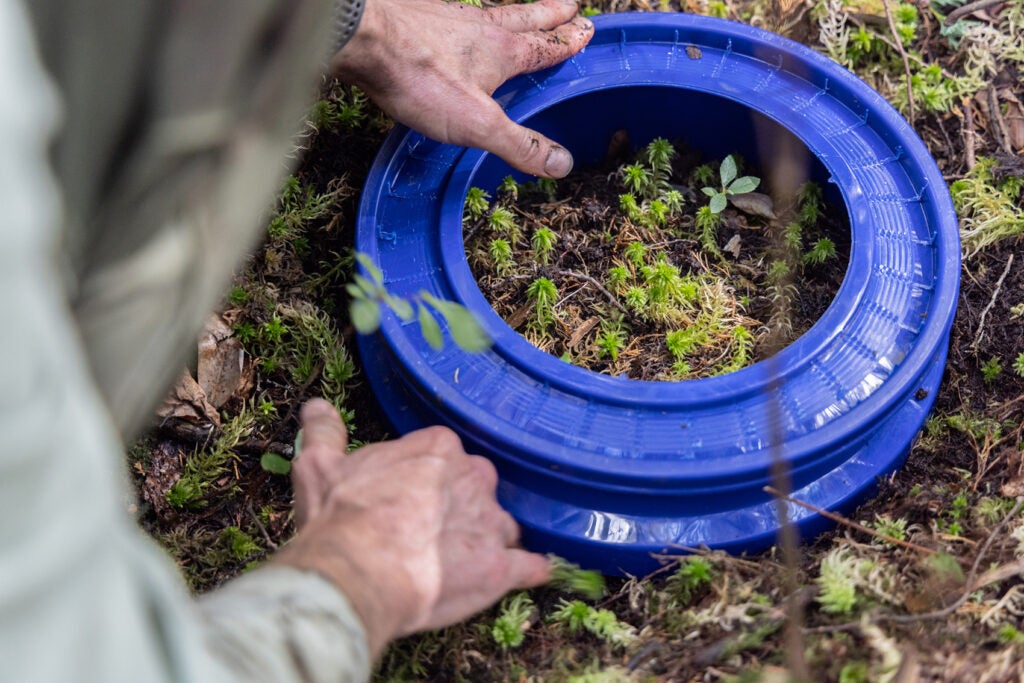
And this is where century’s worth of carbon is stored, in 5 feet of muck beneath his feet. The decay is slow, if at all – in part because cedar doesn’t decompose quickly – but also because there’s no oxygen in this soil, so the organisms that typically decompose organic material aren’t here.
Instead, Schutte says it’s other organisms here that produce methane.
Methane is important to measure because it actually traps more heat in the atmosphere than carbon dioxide within a span of several decades, and so can contribute more to climate change. The focus on cutting methane emissions could more quickly reduce atmospheric warming.
“So there’s a lot of methane in the soil beneath us,” Schutte said. “Some of that can slowly work its way up and make its way directly into the atmosphere. Some of that will work its way up actually through the tree stems and it’ll kind of come out the side of the tree trunk and into the air that way. Some of it will stay dissolved in the groundwater and flow underneath our feet out towards that creek down there.”
Schutte will measure all of those escape routes, and compare results to the other forests.
“If the cedar trees have a lower warming effect than the deciduous trees that they’re replacing, then that act of replacing the deciduous trees with cedar trees can have a cooling effect on the atmosphere,” Schutte said. “And that’s important because that’s one of the things we’re trying to do right now is have a cooling effect.”
The DEP’s Moody said that’s important information for regulators.
“Looking at greenhouse gas mitigation is a big deal in New Jersey and we’re spending a lot of time trying to understand what the environment is doing on its own because that’s gonna help inform us of what we need to do as people in the state,” Moody said.

The DEP is funding this research with a $360,000 grant. Collaborators on the study include the Partnership for the Delaware Estuary and the U.S. Department of Agriculture Natural Resources Conservation Service.
Moody said measuring the amount of carbon emissions trees put into the atmosphere from their trunks is pretty standard and simple to do with the right instruments. The project will also measure the amount of methane that escapes from the soil. Using plastic buckets with the bottoms cut off, Schutte and Moody place them on the soil and will return later with instruments that can detect the emissions flowing from the soil surface.
But this project wants to add another piece to the puzzle: How much methane escapes into the atmosphere through the groundwater that drains from the century-old muck into a nearby stream? That groundwater carries dissolved methane to the surface, which then dissipates into the atmosphere.
That’s where the well drilling comes in, which includes inserting the PVC piping far enough to reach the sandy layer of an ancient seabed.
Schutte’s not sure what they will find, and as a scientist he has to keep an open mind, but he has a guess.
“I think we’re gonna find a lot of methane in the soil,” Schutte said. “I think we’ll measure a lot of methane being emitted to the atmosphere from this type of soil. But taking all these pieces and putting them together to try to build this balance to make this kind of complete equation is something that doesn’t happen very often. It takes more effort, it’s harder to do.”
For Schutte and Moody, it’s important that if the state is going to invest in this research, the work has to have practical applications.
“If we have greenhouse gas reduction goals, we really want to know what our land is already doing for us,” Moody said. “We just want to be sure that the projects are storing the carbon that we think they are.”

Schutte said they should have results within two years. But when it comes to climate change, the time it takes to do good science has a cost.
“One of the things I worry about is that it’ll get out ahead of us,” Schutte said. “A lot of things I’m measuring I’d like to be able to predict how the ecosystem will change, how it will respond to sea level rise or climate change. It’s hard to study because the environment’s changing so fast that you can’t keep up with it.”
Moody said science can show clearly what is happening with ecosystems, but it’s what people and governments do with the information that matters most.
“You know, at some point, we’re going to have to start living differently,” Moody said. “The question is, will we?”
But he realizes that’s not something science can answer.
WHYY is your source for fact-based, in-depth journalism and information. As a nonprofit organization, we rely on financial support from readers like you. Please give today.





